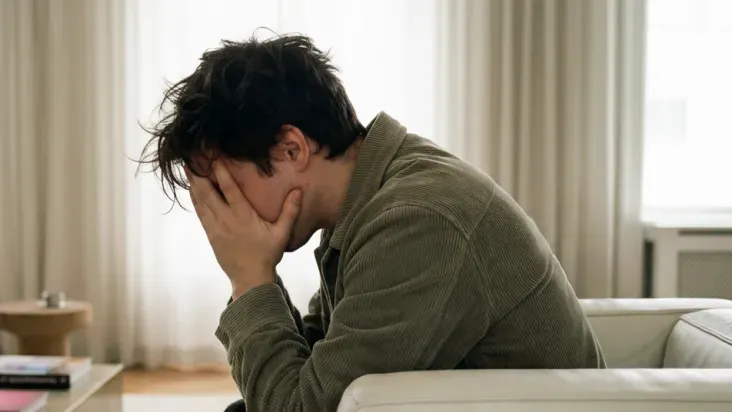The Difference Between an Anxiety Attack and a Panic Attack

If you have ever felt your heart racing and difficulty breathing as fear overwhelms your thoughts, you may have asked yourself, “Am I having a panic attack, or is this an anxiety attack?”
If that was the case, you’re not alone. It’s common to blur the distinction between them, as they can appear alike and manifest in similar ways. Exact numbers about how many people experience panic attacks are not available, as many episodes are not formally recorded. Still, the World Health Organization states that more than 359 million people live with anxiety disorders.
The numbers of panic attacks show that up to 11% of the global population can experience panic attacks in a single year, and many people live with panic disorders. Understanding how panic attacks and anxiety attacks differ and what makes them similar allows us to be more prepared if we experience them or support people we know.
Today, we’ll cover the main differences and similarities between anxiety and panic attacks, explain their symptoms, and suggest a few strategies to deal with them.
Key Learnings
- Anxiety attacks develop gradually in response to identifiable stressors, while panic attacks occur abruptly, peak within 10 minutes, and can happen without any clear trigger.
- Anxiety involves a prolonged activation of the body’s stress response, whereas a sudden surge of dread marks panic attacks.
- Psychoeducation and targeted coping strategies have been shown to significantly reduce the intensity and frequency of both anxiety and panic symptoms.
The Key Differences Between Panic and Anxiety Attacks
Mental health professionals and researchers state that psychoeducation about panic and anxiety attacks has been found to reduce panic symptoms and anxiety levels significantly. Let’s build on this knowledge and learn more about these two concepts. Although anxiety and panic attacks can appear similar, there are a few key differences that allow us to distinguish between them.
An anxiety attack isn’t an official diagnosis, but it is often used to describe intense anxiety, tension, or overwhelm that build up in response to stress. A panic attack, in turn, is a sudden surge of intense fear or discomfort that peaks within a few minutes and can occur without any apparent reason. Panic disorder is included in the Diagnostic and Statistical Manual of Mental Disorders (DSM-IV).
Onset and Progression
Anxiety attacks and panic attacks develop differently.
Anxiety attacks build up gradually. Anxiety symptoms are often tied to ongoing stress or worry, but they are not just that, contrary to one of the popular myths about anxiety. Usually, a person is worried about something in their life, such as an upcoming deadline or a conflict. Here’s what Anxiety & Depression Association of America (ADAA)’s guest author, Gina Bel, wrote about her experience with an anxiety attack:
“My journey with anxiety has been going on my entire life but exploded five years ago in the form of an anxiety attack. I had just landed in Hawaii and started to feel sweaty and sick to my stomach. My breathing became rapid and short. We collected our bags and went to urgent care. I was having an anxiety attack, but I did not know it. I had no idea why or what was happening, and I was far from home.”
Bell adds that her severe anxiety has always occurred in similar circumstances.
The physical symptoms of an anxiety attack develop over time. You may start the day feeling a bit on edge, and as the hours go by, your heartbeat can increase and your sweating can intensify. The increase in tension can occur for hours.
Panic attacks, on the other hand, appear suddenly and without warning. A person can walk and talk to friends when they are hit with a wave of sudden fear. After it occurs, the panic attack usually peaks within 5 to 10 minutes and then its symptoms subside.
Here is another story from Dr. Elain Ryan about her first panic attack when she didn’t know what it was back then:
“I had just finished a phone call late at night and felt what I could only describe as electricity travelling up through my legs… Very quickly, I found it hard to breathe. My face was tingling, and the air was not getting in. I was suffocating… I believed, without a doubt, that I was dying. I checked my pulse, and it was very faint. I was alone.”
Mental and Emotional State
Our focus during each of these experiences varies, too.
During an anxiety attack, thoughts usually revolve around a specific concern or anticipated event. Anxiety causes overthinking, creating a feeling of tension and an inability to relax. You might be second-guessing every choice and imagining some of the worst-case scenarios. Sometimes it comes with a sense of awareness of the source (for example, you know you are worried after an argument with a friend), but it’s not always the case: the tension can build inside us without us knowing what is happening. Sometimes the body’s signs of anxiety feel like normal things, like being tired or having had too much coffee, so we often don’t recognize them as anxiety at first.
During a panic attack, the fear tends to be more instinctual and less rational. We might not even be aware of our worry, or we might not have an obvious trigger. When it hits, we feel like something terrible is about to happen to us right now, that something life-threatening is imminent. Unlike anxiety, which is usually associated with thinking (sometimes too much so), panic attacks are more about sudden terror.
Many people experience traumatic life events and need help in managing their anxiety and panic disorders. If you believe this is the case for you, taking the quiz and receiving your personalized plan for a calmer mind may be a good way to explore your risk factors, family history, and learn what you can do to feel better.
Anxiety and Panic Attack Symptoms
During an anxiety attack, the body’s stress response stays activated for longer periods. Symptoms may be uncomfortable, but most people can cope with them when provided with the right tools. At the same time, during a panic attack, the sensations are more sudden and intense. Even if some symptoms are similar to anxiety attacks, they are much more overpowering.
| Anxiety Attack | Panic Attack |
|
|
These are the common symptoms, but every person’s experience is unique, and the variability of these sensations when fear hits can be high.
Lingering effects following an episode
Anxiety attacks last longer and fade slowly. While they aren’t as severe as panic attacks, they tend to “cling to” a person for hours. People may find it difficult to manage anxiety for a long time.
Panic attacks, however, peak quickly and usually end within minutes. Even after you regain control, they leave you drained, shaky, and anxious about when the next one might come.
Predictability
As a rule, anxiety attacks have identifiable causes because they occur as a response to a trigger. They can happen more often to people who have a history of anxiety. Plus, these attacks have identifiable triggers. This makes it relatively predictable for people who have anxiety disorders, and it allows them to become aware of warning signs in which they can utilize the best coping skill for them in the moment.
However, it is not always the case. Sometimes, we can be unaware of the triggering thoughts and only feel the physical reactions when they have already escalated. Juliette Berton shares with Mental Health Research:
“I hadn’t been aware of what the thoughts were that began this physical response and by the time it occurred to me that this was an anxiety attack, the physiological effects were so great they had become my new focus, not the thoughts that caused them.”
Panic attacks can occur even during sleep or relaxation, often without a specific cause. This makes it more overwhelming. Because people cannot identify triggers or know how to prepare, they may find it challenging to manage symptoms.
When Anxiety Triggers Panic
Anxiety and panic don’t always exist separately; sometimes, they can be interconnected. People who experience panic attacks frequently demonstrate high anxiety levels even on days when the panic does not appear. Here’s how it works.
When we carry stress, it changes how we perceive the world. Our bodies stay on alert even in non-threatening situations, and we hold these intense feelings with us. Even on a regular day, your heart may already be beating faster, your breathing a bit shallower, and your thoughts racing.
That’s when even a small trigger can play a bigger role. Even a small change, such as noticing your own heartbeat or feeling dizzy, can spark a sense that something is wrong. This destabilizes our sense of safety until fear overwhelms us, and it pushes us into a full-blown panic attack.
In other words, anxiety creates the conditions, and panic is the body’s sudden reaction to those conditions reaching a breaking point.
Here is a schematic overview of how this cycle might work:
- You’re anxious about stressful events.
- Your chest feels tight, you have trouble breathing, and you worry it might be something serious.
- Your fear escalates.
- Your body reacts with a surge of adrenaline, which leads to a panic attack.
Paying attention to how we feel is crucial because it allows us to catch the early signs of anxiety before it escalates into either anxiety or a panic attack. When we remain calm and self-aware, we can interrupt the cycle earlier.
How to Cope With Anxiety and Panic Attacks
The differences between anxiety and panic attacks call for slightly different approaches when you experience one of them in the moment. Here are a few relaxation techniques and steps you can try out to calm your panic or anxiety attack. The more you practice, the easier it will be for you to master stress management daily.
During an Anxiety Attack
- Acknowledge what is happening. Tell or think to yourself, “This is anxiety.” Naming it gives your brain the knowledge that even while this state isn’t pleasant, it isn’t dangerous, and you can see it.
- Ground yourself. Anxiety symptoms get more pronounced if you let racing thoughts in, but grounding yourself in reality helps you separate yourself from them. Look around and describe five things you see, four things you can touch, three things you can hear, two things you can smell, and one thing you can taste. This grounding technique, known as the 5-4-3-2-1 method, can be adapted to suit each individual's needs. Check out a short article from the University of Rochester Medical Center to learn more ways to manage anxiety.
- Calm your breathing. Once you are more grounded, try this deep breathing exercise: inhale for 4 seconds, hold for 7 seconds, and exhale slowly for 8 seconds. Dr. Andrew Weil popularized it as a simple method to reduce stress, calm the nervous system, and promote relaxation or sleep.
- Relax your body. If you don’t have much time, try to unclench your jaw and drop your shoulders. Then, do just a few gentle stretches. However, if you have at least a few minutes, try progressive muscle relaxation (PMR). Birmingham and Solihull Mental Health NHS Foundation Trust offers a helpful worksheet that you can download and use as needed.
- Redirect your energy. To not let the anxiety back in or reduce the symptoms you have, try to do something else instead. Ideally, try to move around (even a short walk will be great) or engage in a task that fascinates you.
During a Panic Attack
- Gently remind yourself that it will pass. Panic attacks cause fear, and we can reduce this sensation by saying, “This is a panic attack. It’s temporary. I’m safe.” It allows you to gently try to move away from the fight-or-flight response you are locked in.
- Focus on your breath. It may be challenging when you are panicking, but paying attention to your breathing is an essential step toward calming down. Place a hand on your belly and try to lengthen your exhales slightly more than your inhales, as much as you can. Also, here’s an effective breathing exercise video you can play during a panic attack.
- Find a physical anchor. During a panic attack, we need something solid, something that can distract us from the rush of dread. A textured object, such as your own clothing or a cool wall surface, can help you reconnect with the present moment.
- Use a grounding mantra. Repeat simple phrases, such as “I am here” or “It will fade.” Concentrate on your voice and the words you hear.
- Stay still and let the wave pass. Resisting the feeling can intensify it. Instead, sit somewhere safe and, if you feel comfortable, close your eyes. Let the emotions rise and fall naturally. As we’ve mentioned above, most panic attacks peak within minutes and then slowly end.
- Rest. Unexpected panic attacks may leave you physically and emotionally drained. Drink water and give yourself time to recover. If the situation allows, take some time off and let your body recharge. In summary, be kind to yourself and your body.
Tools to Help You Cope with Anxiety and Panic Disorders
Multiple tools can help you either minimize your attacks or even be used if you have an anxiety disorder or a panic disorder.
Apps
- Rootd. This app helps users feel better during or after an anxiety or panic attack and provides education on risk factors and relaxation techniques to manage it, including deep breathing, mindfulness, grounding, and other coping strategies.
- Worry Watch. This program features tips for people experiencing anxiety, including a guided anxiety journal.
- Dare. With it, users learn to handle their anxiety and panic attacks and manage their emotions in various situations. It strongly relies on exposure therapy to gradually improve your mental health condition.
- Mind Ease. It supports people in dealing with anxiety and panic and explains various practical techniques.
💡Tip: Liven’s Mood Tracker can help you find out when your anxiety spikes most. By regularly acknowledging your emotions, you can notice the patterns that indicate what may have been bothering you.
Worksheets & Tools
- Panic Attack Talkdown. This video helps gently soothe your emotions and offers guidance during a panic attack.
- Spoken Affirmations for Panic Attack, Anxiety. The speaker voices affirmations for panic or anxiety attacks to help you during the moment of crisis.
- Grounding Techniques. If you want to learn more about grounding techniques and have a quick rundown, here’s a short, comprehensible list from Clearwater Free Clinic.
- Panic Attack Workbook. Presented by Between Sessions Interactive, this free workbook provides information on panic attacks and daily exercises.
Taking Care of Your Mental Health
Dealing with anxiety and panic attacks starts with understanding how they work. Educating yourself about their mechanisms and progression prepares you for the future. Experiment with various grounding and breathing techniques to create your own toolkit. Over time, you will be able to face your panic and anxiety attacks with more confidence.
References
- Anxiety disorders. World Health Organization. (2025a, September 8). https://www.who.int/news-room/fact-sheets/detail/anxiety-disorders
- Barnhill, J. W. (2023, August). Panic attacks and panic disorder. MSD Manual Professional Edition. https://www.msdmanuals.com/professional/psychiatric-disorders/anxiety-and-stressor-related-disorders/panic-attacks-and-panic-disorder
- Bell, G. (2022). My journey with anxiety. Anxiety & Depression Association of America. https://adaa.org/living-with-anxiety/personal-stories/my-journey-anxiety
- Burton, J. (2024, June 24). What does it feel like to have an anxiety attack?. MQ Mental Health Research. https://www.mqmentalhealth.org/what-it-feels-like-to-have-an-anxiety-attack/
- Clare, T. (2022, May 22). My life was ruled by panic attacks. Here’s my seven-point guide to tackling anxiety. The Guardian. https://www.theguardian.com/lifeandstyle/2022/may/22/my-life-was-ruled-by-panic-attacks-how-tim-clare-learned-to-cope-with-anxiety
- 5-4-3-2-1 coping technique for anxiety. University of Rochester Medical Center. (2018). https://www.urmc.rochester.edu/behavioral-health-partners/bhp-blog/april-2018/5-4-3-2-1-coping-technique-for-anxiety
- Lack, C. W. (2024). Anxiety disorders. Psychiatric Clinics of North America, 47(4), 613–622. https://doi.org/10.1016/j.psc.2024.04.008
- Miqdadi, A. I., Chong, M.-C., Tang, L.-Y., Koh, O.-H., Alhadidi, M., & Issa, M. (2024). Easing panic: The effect of an online psychoeducational program on panic symptoms, anxiety, and quality of life among people experiencing panic attacks. Issues in Mental Health Nursing, 45(10), 1022–1033. https://doi.org/10.1080/01612840.2024.2384412
- Ranganathan, A., & Beitman, B. D. (1998). Panic disorder: a different perspective. Mo Med.
- Ryan, E. (2025, August 16). My first panic attack - a psychologist’s personal story of recovery. Dr Elaine Ryan. https://mytherapist.ie/panic-attack-recovery/first-panic-attack/
- Samokhval, V. (2025a, May 15). 8 myths about anxiety debunked: Facts vs. misconceptions. Liven App. https://theliven.com/blog/wellbeing/anxiety/8-common-myths-about-anxiety
- Samokhval, V. (2025b, September 12). The role of emotional regulation in stress management. Liven App. https://theliven.com/blog/practices/calm/effective-stress-management-practical-strategies
- Spytska, L. (2025). Exploration of personality characteristics of individuals with panic attacks: A personality profile study. Journal of Infant, Child, and Adolescent Psychotherapy, 24(1), 84–94. https://doi.org/10.1080/15289168.2025.2450195
- Tsai, S.-J., Cheng, C.-M., Chang, W.-H., Bai, Y.-M., Su, T.-P., Chen, T.-J., & Chen, M.-H. (2025). Panic disorder and suicide. Psychological Medicine, 55. https://doi.org/10.1017/s0033291724003441
- Qu, X. (2024). The Causes and interventions of PTSD. Journal of Education, Humanities and Social Sciences, 26.


